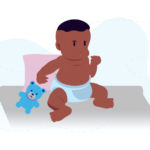Broken signals: Things you may not know about nerve injury

When Dr. Andrea Bauer talks about nerve injuries, she talks about phone cords. A damaged phone cord transmits staticky or broken sounds, or no sound at all. Similarly, peripheral nerve injuries (injuries that affect the arms, hands, legs, and feet) disrupt signals to and from the brain, causing numbness, loss of sensation, and lost function. When this happens, many families don’t know where to turn.
Fortunately, says Dr. Bauer, nerve repair has come a long way in recent years. But unfortunately, many patients, families, and even some doctors, don’t know this. The gap in knowledge can delay care, giving a treatable nerve injury time to become permanent.
Here, Dr. Bauer, an orthopedic surgeon in the Hand and Orthopedic Extremity Program at Boston Children’s Hospital, answers questions about nerve injuries, nerve repair, and why upper extremity surgeons have surprising expertise in this area.
What do you wish more people knew about nerve injuries?
Some damaged nerves heal on their own, but some injuries are too severe for the nerve to regrow. If a patient has a serious peripheral nerve injury, we have methods to restore muscle function that didn’t exist 30 years ago.
But it’s also important to know there’s often a ticking clock with nerve injuries. When a patient loses mobility in an arm or leg, you often can’t get nerve function back if you wait too long. After 12 to 18 months, the connection between the nerve and muscle dies off and can no longer be restored.
How do you repair a damaged nerve?
Essentially, we create a new connection. One way to do this is with nerve transfer: we redirect a nearby, healthy nerve to the denervated muscle (a muscle that’s not receiving nerve signals). The other is nerve graft: we take a section of nerve from another part of the body and use it to create a new path around the damaged section of nerve.
These procedures were first developed to restore arm function in adults with traumatic brachial plexus injuries. Today we use these procedures to repair nerves all over the body in patients of all ages.
How will a parent know if their child has a nerve injury?
They may not know. The symptoms aren’t always obvious and aren’t always painful. A great example of this is the axillary nerve (a nerve that runs through the shoulder). The most common symptom of axillary nerve damage is muscle weakness, but often there’s no pain, swelling, or bruising, so the family may think the arm is fine.
Parents should watch for a change in muscle size after injury. A smaller muscle could be a sign of nerve injury. They should also look for isolated weakness, for instance, the injured arm remains weak even after the injury seems to have healed.
What is the likelihood a patient will recover function after nerve repair?
Recovery depends on a lot of things, including the timing of care and severity and location of the injury. The sooner the connection between the nerve and muscle is restored, the better. There’s also a better chance of recovery if the nerve damage happens close to the muscle since the slowly re-growing nerve has less distance to cover.
When do you recommend nerve repair surgery?
If there’s not a reasonable chance a patient will regain at least some function in their arm or leg, we won’t recommend surgery. When we do, we make sure families know that they may not see improvement for three to nine months, and that recovery can take up to two years. The brain needs to learn, through exercises and physical and occupational therapy, how to communicate with the muscle through the new pathway.
Why are upper extremity surgeons involved in nerve repair?
Brachial plexus nerve repair is part of our training as hand and upper extremity surgeons. Between that and our training in muscular and skeletal injuries, we are often the first to recognize peripheral nerve injuries. However, when a child has nerve damage, we rarely work alone.
At Boston Children’s, we’re lucky to work with experts in neurology, neurosurgery, plastic surgery, and pain management. Through close collaboration with our colleagues in these departments, we can assess possible nerve damage, the extent of the damage, and develop an appropriate plan of care.
Learn more about the Hand and Orthopedic Upper Extremity Program and Brachial Plexus Program.
Related Posts :
-

Answers for parents whose baby is born with brachial plexus injury
Between one and three of every 1,000 babies is born with brachial plexus birth injury. The injury, which may be minor ...
-

Brachial plexus birth injury: Harper’s right arm
When Harper Jane Stalker was born with a limp, unmoving right arm in 2016, her parents had never heard of brachial ...
-

The mystery of Jane’s left shoulder: Acute flaccid myelitis
When 5-year-old Jane Morehead tumbled off her bike in May 2017, it didn’t seem like a big deal. Jane’s ...
-

Returning to the stage after cubital tunnel syndrome
Bruno Silva can’t imagine his life without music. He has been playing bass guitar since he was 12 years old ...





